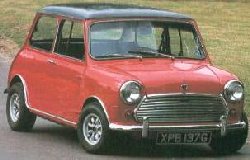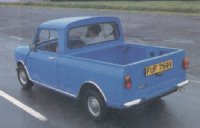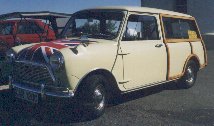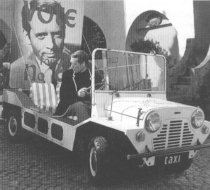



 The Suez Canal Crisis in the 1950s prompted BMC (British Motor Corporation) to manufacture a car stingy on petrol yet able to carry four passengers and luggage adequately. This task fell upon a single man, Sir Alec Issigonis, who went ahead and designed the Mini, a car so innovative in terms of packaging that its concept is used by almost all modern front-engined front wheel drive cars today. Issigonis used transverse-mounted front engine, front wheel drive with gearbox under the engine (which shared the motor oil from the engine, like motorcycles), and small 10" wheels at the corners, in order to house four passengers comfortably in a 10' x 4'7" x 4'5" (length x width x height) size. Rubber cones instead of conventional springs were used in order to control the suspension travel caused by up to 50% difference in weight from having to carry one to four passengers (The Mini would use hydroelastic suspensions later on). When first released by BMC in 1959 as Morris Mini-Minor and Austin Se7en, the badge-engineered Minis came with 848cc (34bhp @ 5500rpm) A-series engine, capable of propelling it to 75mph.
The Suez Canal Crisis in the 1950s prompted BMC (British Motor Corporation) to manufacture a car stingy on petrol yet able to carry four passengers and luggage adequately. This task fell upon a single man, Sir Alec Issigonis, who went ahead and designed the Mini, a car so innovative in terms of packaging that its concept is used by almost all modern front-engined front wheel drive cars today. Issigonis used transverse-mounted front engine, front wheel drive with gearbox under the engine (which shared the motor oil from the engine, like motorcycles), and small 10" wheels at the corners, in order to house four passengers comfortably in a 10' x 4'7" x 4'5" (length x width x height) size. Rubber cones instead of conventional springs were used in order to control the suspension travel caused by up to 50% difference in weight from having to carry one to four passengers (The Mini would use hydroelastic suspensions later on). When first released by BMC in 1959 as Morris Mini-Minor and Austin Se7en, the badge-engineered Minis came with 848cc (34bhp @ 5500rpm) A-series engine, capable of propelling it to 75mph.
 This four cylinder engine was considered adequate for the Mini, whose original intent was to be a cheap, utilitarian transport. However, John Cooper, a Formula 1 car builder (World Champion in 1959 and 1960) saw the Mini as more than utilitarian, and wanted to exploit its power-to-weight ratio for racing. The Mini-Cooper was born, and along with it came more powerful 997 and 998cc engines. To handle the extra power, front disc brakes came standard on Mini-Coopers. Despite many rally victories, the Mini's exclamation point in motor racing came with the even more powerful Mini-Cooper S's, which came with 1071, 970, and the legendary 1275cc engines. These Super Minis won the Monte Carlo Rally in 1964, 1965, 1966, and 1967 - the only thing preventing the Minis from "officially" winning four years in a row were politics, when in 1966, the 1-2-3 finishing Mini-Cooper S's along with other British entries were disqualified for some bogus headlight rules infringement. In 1971, BMC decided to do some cost cutting/downsizing (rightsizing for you politically correct folks) and decided to stop paying John Cooper royalties for the Cooper name. This spelled temporary death for the Mini-Cooper (the name came back in 1990). However, the Mini is still being manufactured by Rover today - it's a testament to the Car of the Century which can survive despite politics and economics.
This four cylinder engine was considered adequate for the Mini, whose original intent was to be a cheap, utilitarian transport. However, John Cooper, a Formula 1 car builder (World Champion in 1959 and 1960) saw the Mini as more than utilitarian, and wanted to exploit its power-to-weight ratio for racing. The Mini-Cooper was born, and along with it came more powerful 997 and 998cc engines. To handle the extra power, front disc brakes came standard on Mini-Coopers. Despite many rally victories, the Mini's exclamation point in motor racing came with the even more powerful Mini-Cooper S's, which came with 1071, 970, and the legendary 1275cc engines. These Super Minis won the Monte Carlo Rally in 1964, 1965, 1966, and 1967 - the only thing preventing the Minis from "officially" winning four years in a row were politics, when in 1966, the 1-2-3 finishing Mini-Cooper S's along with other British entries were disqualified for some bogus headlight rules infringement. In 1971, BMC decided to do some cost cutting/downsizing (rightsizing for you politically correct folks) and decided to stop paying John Cooper royalties for the Cooper name. This spelled temporary death for the Mini-Cooper (the name came back in 1990). However, the Mini is still being manufactured by Rover today - it's a testament to the Car of the Century which can survive despite politics and economics.
Mini Pick-up
| Mini Estate (Van similar)
|
Riley Elf (Wolseley Hornet similar)
| Mini Moke
|
 - What's preventing you from owning a Mini? They got parts!
- What's preventing you from owning a Mini? They got parts!
 - Snorty and Co. a very funny comic strip!
- Snorty and Co. a very funny comic strip!

| What's New | Main Page | Mini Page | Mustang Page | MOASF Photos | Race Page |
This page hosted by ![]()
Get your own Free Home Page